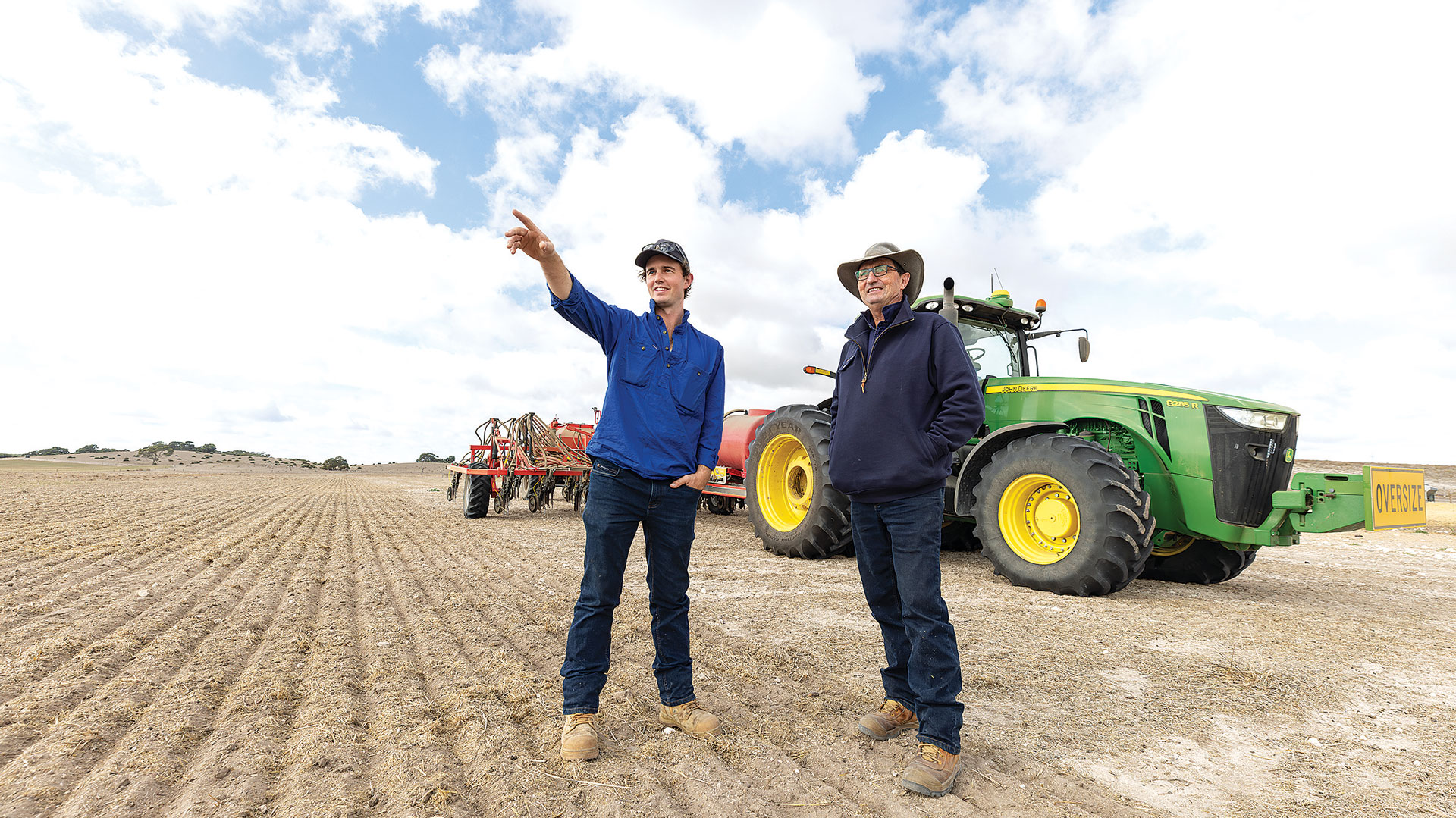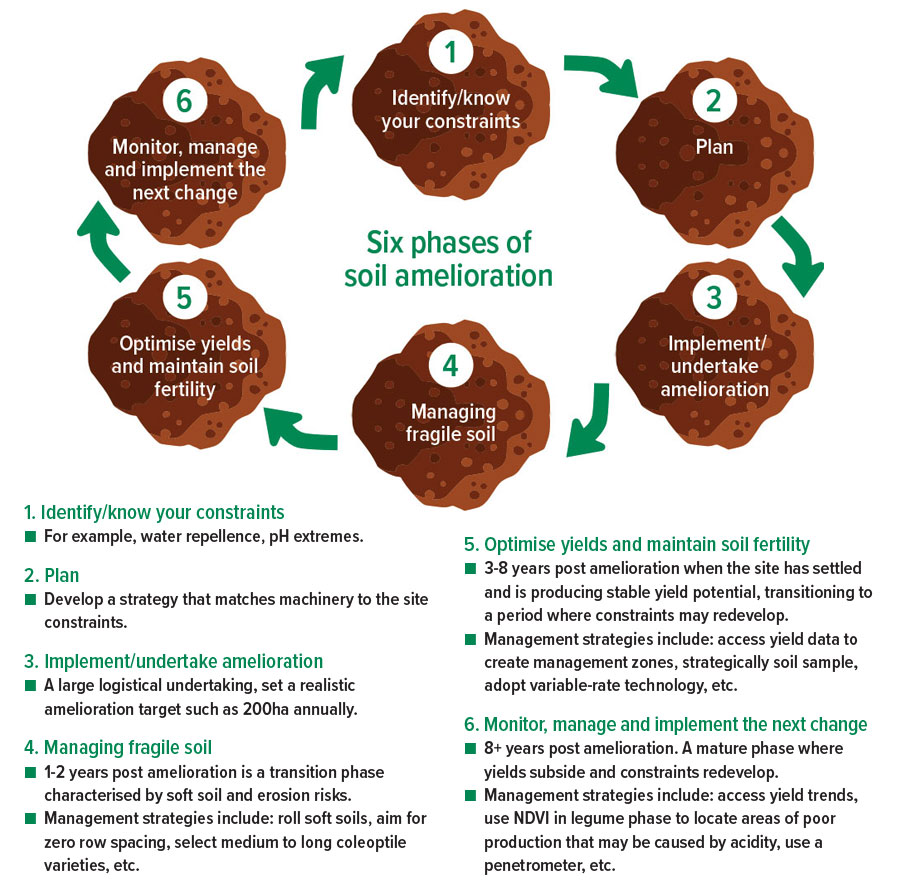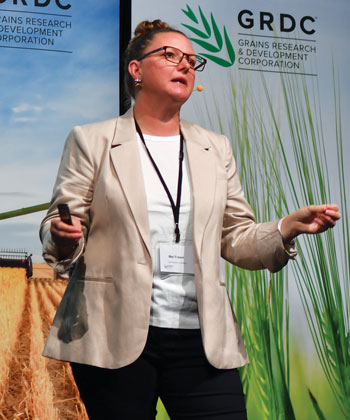For Anthony Pfitzner, South Australian trials looking into minimising risks and improving establishment post-amelioration have been a revelation.
The seventh-generation grain grower had long cropped on the stable red brown earth of Eudunda, 100 kilometres north of Adelaide. But six years ago, he bought land 200km south, at Coomandook, to expand and provide opportunities for his sons.
There, the shifting, water-repellent, acidic and sandy soils were a complete contrast to what he was accustomed to, so he has been heavily invested in the amelioration trials he is hosting. “It’s been massive learning curve,” he says.
Co-funded by SARDI and led by Dr Melissa Fraser of Soil Function Consulting for the MacKillop Management Group, the trials have been run over two years at Coomandook and Sherwood, 130km further south.
Identified as a research, development and extension need through the GRDC National Grower Network, the trials have provided evidence for best agronomic practice immediately after and for the years following amelioration to capitalise on the improved soil potential.
Anthony says the research has provided important cropping insights in the changed environment: “It became apparent that we had to change our management once we ameliorated because our yield potential is now greater through the increased water-holding capacity and the potential of the soils,” he says.

Jeremy Lush and father Rodney are zoning paddocks to target inputs. Photo: Adrian Gale
Site-specific
Dr Fraser explains the two trial sites – at Coomandook and Sherwood – have characteristics that have guided the research.
Coomandook is a site characterised by severely water-repellent, deep sandy soils devoid of clay and prone to compaction typical across the Victorian and South Australian Mallee. So the focus there began with strategies to aid establishment and reduce risks such as erosion associated with a soft seedbed immediately after amelioration.
It found that consolidating the seedbed pre-sowing reduced seeder sinkage and excessive soil throw and improved crop establishment. Combining seed broadcasting with in-row seeding also increased early ground cover and reduced wind erosion risks.
Looking at the impact of different amelioration techniques, the trials compared an inversion-style plough, such as a Plozza, to a chisel plough, in this case a Bednar Terraland.
Dr Fraser says chisel ploughing is not effective at treating water repellence if the profile is devoid of clay to bring to the surface. In Coomandook’s deep sandy soils, crops on plots ameliorated with a chisel plough had weaker establishment in year two than those on the inversion-ploughed plots, although they caught up over time.
“Understanding your subsurface characteristics and how a machine might actually behave in your environment is really important.”
For Anthony, the research comparing the impact of chisel and inversion techniques was welcome news, confirming the Plozza plough he had sourced from “under a tree” at his uncle’s Griffith farm was fit for purpose in his particular soil type.
Working to a depth of about 30 centimetres, it has alleviated shallow compaction, allowed roots to penetrate deeper and brought up wettable sand. “So the Plozza is fixing our repellence issue,” he says.
Twin trials
At Sherwood, in a region where growers have been ameliorating with clay for more than 30 years, replica trials were established on a delved flat and a clay-spread sandhill. Designed to test post-amelioration management strategies to maximise yield potential, the twin trials showed significant differences between yields on the flats and the hills, despite having the same history and receiving the same treatment.
Sherwood grower Jeremy Lush, who crops just 5km from the trial site, says it was valuable to observe how the characteristics of the soils affected crop yield.
“You might assume that if you grow a bean crop, you’re fixing a consistent amount of nitrogen across the paddock, but these trials showed you were fixing half or two-thirds of the amount of nitrogen up on the hill as you were on the flat,” he says.
Dr Fraser says this illustrates the importance of using a zone-based approach post-amelioration to ensure inputs match varying levels of increased yield potential.
Greater yields
Dr Fraser says the trials have demonstrated the overall yield benefit of ameliorating soils when followed by appropriate agronomy.
Planted to canola in 2023, the Coomandook trial showed benefits such as greater plant vigour, higher yields and good establishment on ameliorated versus control plots.
Where water repellence was addressed, sowing rates could be reduced, saving money without a yield penalty, providing adequate nutrition was applied, she says.
Even with 2023’s dry finish stunting yields, the addition of extra nitrogen (150kg/ha compared with a baseline 94kg/ha) on ameliorated sites returned yields of 2.3 tonnes per hectare compared with 1.6t/ha on the control plot.
Similarly at Sherwood, combined yields of wheat (2022) and canola (2023) exceeded the economic yield potential target of 7.2t/ha on the delved flats after amelioration and with extra nitrogen.
When analysing the benefit of amelioration, Dr Fraser says it is important to look over successive years rather than just one in isolation. This accounts for seasonal changes, but also the impact of residual nitrogen and improvements in the soil over time.
The canola and wheat yields together at Sherwood, for example, showed how effective canola was at extracting the extra nitrogen from the soil. And this demonstrates that extra inputs are not wasted in an average year as they can be utilised by a plant, even years later.
“The message is to set realistic yield targets and be responsible with your inputs, but don’t be scared to test a new strategy.”
The impact of stored nitrogen is something that heartens Jeremy after he, like many growers in 2023, fed crops in response to a wet winter only to be cruelled by a dry spring. “While we didn’t achieve crop potential last year, it’s good to know the nitrogen and the phosphorus is still there, and crop potential is right up if we have the finish.”
Amelioration phases
Dr Fraser says soils should be managed and analysed carefully across several years and distinct phases post-amelioration.
These include a year later when soils are fragile. The next phase, which could last for several years, is when yields are optimised and soil fertility maintained, and a final phase is when constraints may redevelop (Figure 3).
Jeremy says applying appropriate nutrients to meet increased yield potential can prolong the impact of amelioration, which is important from an economic perspective. “You’ve done the hard work and made the investment (on amelioration) and now it’s only another $20, $30, $50 a hectare on nutrition to sustain the results,” he says.
Aiming high
At Coomandook, with trial plots in the fertility phase and with a fuller nitrogen bank and greater biomass above and below the ground, Dr Fraser has designed an agronomy package in 2024 aimed at producing wheat yields of 4.2t/ha – 1t above district average.
“People haven’t been game to pitch for 4.2 before because the soil has been constrained, but if we have overcome those constraints can we get there,” she says.
This year, after “plozzering” another 200ha of country while incorporating lime, Anthony will be increasing nutrition rates above district practice on his ameliorated area, chasing higher yields facilitated by the improved soil profile.
He broadcast 50 to 60kg/ha of extra seed before sowing to prevent erosion and increase yield based on the research, and despite a lack of rainfall at sowing he remained optimistic that five to 10mm would be enough for germination.
Anthony has traditionally favoured barley as the cereal in his rotation for its early vigour, but this year he will trial a paddock of Sunblade CL PlusA wheat with a long coleoptile that aids emergence in deeper sown crops and builds organic matter.
“If we can get wheat to establish then go on with the barley the following year, we’ll have a lot of stubble, a lot of root matter. So then everything’s consolidated and happy and we can go in with a canola or a legume and the system is away,” he says.
Dr Fraser says she hopes the research will help to give growers strategies to confidently manage soils after amelioration to produce ongoing higher returns.
“What we’re really doing here is producing the data to help people have the confidence to take that next step,” she says. “Put on that bit of extra nitrogen early in the season or push that bit extra later in the season and find the motivation to do zone-based soil sampling in the first place.”
Figure 3: Six phases of soil amelioration.

In the zone
 Dr Melissa Fraser presenting at the GRDC Adelaide Grains Research Update. Photo: Melissa Marino
Dr Melissa Fraser presenting at the GRDC Adelaide Grains Research Update. Photo: Melissa Marino
While amelioration trials at Coomandook and Sherwood in South Australia produced specific results relative to their environments, research manager Dr Melissa Fraser says they also showed some significant commonalities that provide insights for growers across the Mallee.
Key among these is the importance of paddock zoning – setting zone-based economic yield targets for different parts of the paddock – after amelioration. While amelioration leads to a yield increase across an entire area, the best parts of the paddock still return higher yields than the worst, she says. Therefore, to maximise returns, those better-performing areas should be provided with higher rates of nutrition.
“We see a lot of growers treating the whole paddock the same after amelioration, but our research is showing that a really targeted strategy – feeding crops to their potential in different zones of the paddock – provides the best chance of achieving the best outcome from year one and to maintain that going forward,” she says.
Dr Fraser says simple tools such as soil sampling could be used pre-sowing, while yield mapping could be employed post-harvest to inform nutrition strategies to close the yield gap in specific zones.
For Sherwood grower Jeremy Lush, these insights have been significant. A zone-based approach to nutrition is one part of an evidence-based decision-making process he has employed around all aspects of his cropping business.
“This trial has changed the way we farm,” he says. “We’ve got all this information that helps us make good decisions, and we are now equipped with the technology that allows us to identify where we are not generating an appropriate return, develop a strategy to give us the best chance of achieving that return, and execute it in the paddock through variable-rate and the like.”
Working with Dr Fraser as a consulting soil scientist, Jeremy is collating yield maps, using normalised difference vegetation index (NDVI) spatial imagery to identify areas to target, and undertaking zone-based soil testing. He is also setting up precision agriculture software to apply nitrogen and phosphorous at a variable rate at seeding and in crop.
For Jeremy, who has been cropping at the Sherwood property for just five years, his testing – and the trials – are providing an invaluable insight into the varying nature of the country.
Trial results, for example, that showed after a bean crop significantly less nitrogen was fixed on the sandy hills than the heavy flats, have prompted him to adjust his nutrition in line with more realistic yield targets for each area.
“We don’t have country that’s consistent enough to just treat everything the same, so we’re identifying the area and soil testing to understand what’s happening and then managing it accordingly,” he says.
More information: Dr Melissa Fraser, mel@soilfunction.com.au

























































